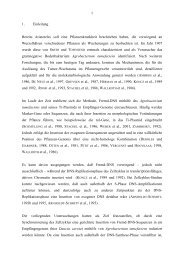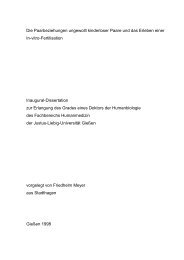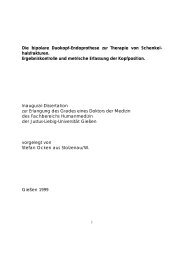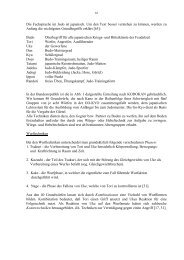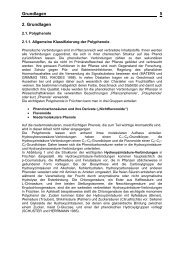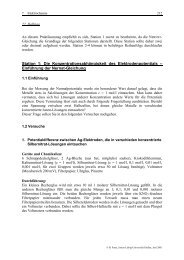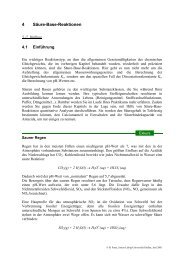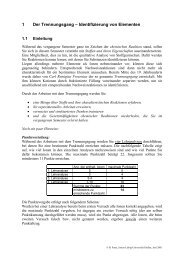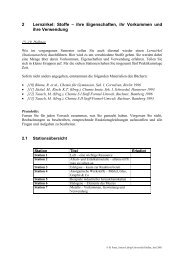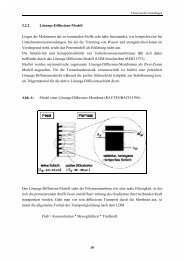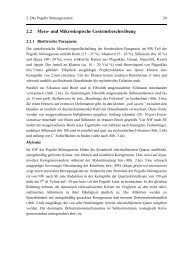Effects of diabaticity on fusion of heavy nuclei in the dinuclear model ...
Effects of diabaticity on fusion of heavy nuclei in the dinuclear model ...
Effects of diabaticity on fusion of heavy nuclei in the dinuclear model ...
You also want an ePaper? Increase the reach of your titles
YUMPU automatically turns print PDFs into web optimized ePapers that Google loves.
The similarity <str<strong>on</strong>g>of</str<strong>on</strong>g> <strong>the</strong> potential energy U as a functi<strong>on</strong> <str<strong>on</strong>g>of</str<strong>on</strong>g> η at <strong>the</strong> touch<strong>in</strong>g c<strong>on</strong>figurati<strong>on</strong> <str<strong>on</strong>g>of</str<strong>on</strong>g> <strong>the</strong><br />
<strong>nuclei</strong> calculated with<strong>in</strong> different approaches can <strong>in</strong>dicate <strong>the</strong> stability <str<strong>on</strong>g>of</str<strong>on</strong>g> <strong>the</strong> results obta<strong>in</strong>ed<br />
<strong>in</strong> <strong>the</strong> DNS <strong>model</strong>.<br />
Us<strong>in</strong>g a small overlap <str<strong>on</strong>g>of</str<strong>on</strong>g> <strong>the</strong> DNS <strong>nuclei</strong>, <strong>the</strong> value <str<strong>on</strong>g>of</str<strong>on</strong>g> U is calculated as <strong>the</strong> sum <str<strong>on</strong>g>of</str<strong>on</strong>g> asymptotic<br />
b<strong>in</strong>d<strong>in</strong>g energies <str<strong>on</strong>g>of</str<strong>on</strong>g> <strong>the</strong> <strong>nuclei</strong> and <strong>the</strong> nucleus-nucleus potential [34, 65] <strong>in</strong> <strong>the</strong> phenomenological<br />
treatment. S<strong>in</strong>ce <strong>the</strong> DNS <strong>nuclei</strong> reta<strong>in</strong> <strong>the</strong>ir <strong>in</strong>dividual properties, <strong>in</strong> this approach <strong>the</strong> shell<br />
effects enter U through <strong>the</strong> b<strong>in</strong>d<strong>in</strong>g energies <str<strong>on</strong>g>of</str<strong>on</strong>g> <strong>the</strong> two <strong>nuclei</strong>.<br />
In <strong>the</strong> microscopical c<strong>on</strong>siderati<strong>on</strong>, <strong>the</strong> DNS potential energy as a functi<strong>on</strong> <str<strong>on</strong>g>of</str<strong>on</strong>g> η can be<br />
calculated with<strong>in</strong> <strong>the</strong> adiabatic TCSM us<strong>in</strong>g <strong>the</strong> Strut<strong>in</strong>sky method. C<strong>on</strong>trary to <strong>the</strong> phenom-<br />
enological approach, <strong>in</strong> <strong>the</strong> TCSM-method we do not need <strong>the</strong> calculati<strong>on</strong> <str<strong>on</strong>g>of</str<strong>on</strong>g> <strong>the</strong> nucleus-nucleus<br />
<strong>in</strong>teracti<strong>on</strong>. There is an alternative microscopical method where <strong>the</strong> energy <str<strong>on</strong>g>of</str<strong>on</strong>g> <strong>the</strong> DNS as a<br />
functi<strong>on</strong> <str<strong>on</strong>g>of</str<strong>on</strong>g> η is calculated us<strong>in</strong>g <strong>the</strong> rate <str<strong>on</strong>g>of</str<strong>on</strong>g> probability <str<strong>on</strong>g>of</str<strong>on</strong>g> nucle<strong>on</strong> transfer between <strong>the</strong> DNS<br />
<strong>nuclei</strong>. In this method, which we call ”alternative microscopical method” to dist<strong>in</strong>guish it from<br />
<strong>the</strong> TCSM-method, <strong>the</strong> energy c<strong>on</strong>ta<strong>in</strong>s not <strong>on</strong>ly <strong>the</strong> potential energy, but <strong>the</strong> c<strong>on</strong>tributi<strong>on</strong> from<br />
<strong>the</strong> k<strong>in</strong>etic energy. Therefore, this driv<strong>in</strong>g potential could deviate from <strong>the</strong> driv<strong>in</strong>g potentials<br />
calculated phenomenologically and with<strong>in</strong> <strong>the</strong> TCSM.<br />
In Sect. 4-1, methods <str<strong>on</strong>g>of</str<strong>on</strong>g> calculati<strong>on</strong> <str<strong>on</strong>g>of</str<strong>on</strong>g> <strong>the</strong> driv<strong>in</strong>g potential <strong>in</strong> <strong>the</strong> phenomenological ap-<br />
proach, with<strong>in</strong> <strong>the</strong> TCSM and <strong>in</strong> <strong>the</strong> alternative microscopical approach are presented. The<br />
isotopic dependence <str<strong>on</strong>g>of</str<strong>on</strong>g> <strong>the</strong> phenomenological driv<strong>in</strong>g potential was analysed <strong>in</strong> [67]. In Sect. 4-<br />
2, we check whe<strong>the</strong>r this dependence is <strong>the</strong> same for <strong>the</strong> driv<strong>in</strong>g potential calculated with<strong>in</strong> <strong>the</strong><br />
TCSM. The isotopic dependence <str<strong>on</strong>g>of</str<strong>on</strong>g> <strong>the</strong> fusi<strong>on</strong> barrier <strong>in</strong> mass asymmetry is studied. The effect<br />
<str<strong>on</strong>g>of</str<strong>on</strong>g> <strong>the</strong> deformati<strong>on</strong> <str<strong>on</strong>g>of</str<strong>on</strong>g> <strong>the</strong> DNS <strong>nuclei</strong> <strong>on</strong> <strong>the</strong> potential energy is dem<strong>on</strong>strated.<br />
4.1 Methods <str<strong>on</strong>g>of</str<strong>on</strong>g> calculati<strong>on</strong> <str<strong>on</strong>g>of</str<strong>on</strong>g> <strong>the</strong> driv<strong>in</strong>g potential<br />
4.1.1 Phenomenological method<br />
The phenomenological driv<strong>in</strong>g potential is calculated as <strong>in</strong> [34, 65]<br />
U(R, η, ηZ) =B1 + B2 + V (R, η, ηZ) − B12, (4.1)<br />
42



